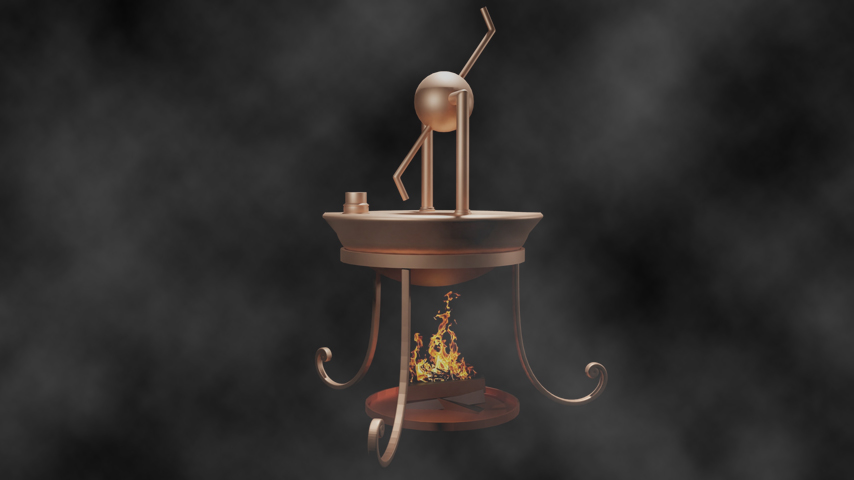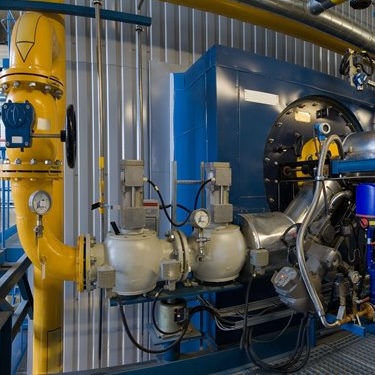5 Steam-Powered Firsts
5 Steam-Powered Firsts


Steam-powered technologies have driven and inspired engineering advances for generations.
Steam has been a source of power for locomotives, turbines, pumps, and more throughout history. The advent of the steam engine during the Industrial Revolution, for example, led to improvements in transportation and manufacturing capabilities the world over. Although the steam engine and its counterparts have been widely replaced by more efficient technologies, the impact of steam-powered technologies on engineering remains. And there are still massive steam-powered turbines found in coal-fired power plants today.
Here are five inventions that made their mark in steam-powered history.
Greek mathematician Heron of Alexandria is credited with inventing the first device powered by steam that demonstrated rotary motion. Called an aeolipile (pictured above), it was comprised of a hollow sphere attached to two hollow vertical tubes rising from a heated receptacle underneath. Steam would travel into the sphere through the two vertical tubes and then escape through two bent tubes on the top and bottom of the sphere that acted much like propellers, thus rotating the sphere. Although Heron's invention set a precedent, it wasn’t actually used for anything other than novelty.
In pursuit of a solution that would move water out of coal mines more efficiently than buckets on pulleys, military engineer Thomas Savery developed what he called an “engine for raising water by fire” in the late 17th century. Simply put, his device comprised a boiler filled with water, into which pressurized steam is introduced, then the tank isolated. Steam would then condense and create a vacuum, so when a valve at the base of the tank is opened, water would be drawn into the tank and ejected out with the help of the steam pressure. However, the device had some inefficiencies and since the technology for tightly sealed joints wasn’t yet available, it had a predisposition to explode.
Although Savery’s device is considered the first commercial steam-powered pump, Spanish inventor Jerónimo de Ayanz y Beaumont actually developed a steam-powered pump system to draw water and gas out of mines before Savery in the early 17th century.

Building on Savery’s invention, inventor Thomas Newcomen developed the atmospheric steam engine in the early 18th century. This machine did what Savery's engine did, but more efficiently. This device was composed of a boiler underneath a cylinder containing a piston. Steam moves from the boiler into the cylinder and once the piston reaches its apex, water is applied to the cylinder, dropping the steam’s temperature and generating a vacuum. Then, atmospheric pressure draws the piston down so the process can start again. This device needed both a constant heat source for the cylinder and a steady flow of water to cool it back down.
Adding a steam engine to various modes of transportation came long quickly enough. The first person to do this on a water-faring vehicle was John Fitch in 1787, when he built a 45-foot steamboat with paddle wheels. Although this was the first steamboat, and he went on to build four more, Fitch’s vessels didn’t stick around due to financial woes.
Robert Fulton and Robert R. Livingston had better luck in 1811 with a steamboat that was built to travel the Mississippi river, until Henry Miller Shreve earned the moniker as father of Mississippi navigation for his launch of the steamboat Washington in 1816. Shreve used a high-pressure steam engine mounted to the hull high above the water line.
Mechanical engineer Richard Trevithick built the first steam railway locomotive in 1804. Dubbed the Penydarren locomotive, it was designed so that the exhaust stem went up the chimney, producing a draft that more powerfully pulled gases from the fire and through the boiler. The first commercial steam locomotive would come along in 1812, the Salamanca, and was built by Matthew Murray. This locomotive’s engine was the first to feature two cylinders and the first to use a rack and pinion system.
Steam would continue to dominate the railways through the late-19th century, when diesel and the internal combustion engine began its rule on the rails. But they're seeing a resurgence, as several operators are bringing steam locomotives back into service in 2024.
Louise Poirier is senior editor.
Here are five inventions that made their mark in steam-powered history.
Aeolipile
Greek mathematician Heron of Alexandria is credited with inventing the first device powered by steam that demonstrated rotary motion. Called an aeolipile (pictured above), it was comprised of a hollow sphere attached to two hollow vertical tubes rising from a heated receptacle underneath. Steam would travel into the sphere through the two vertical tubes and then escape through two bent tubes on the top and bottom of the sphere that acted much like propellers, thus rotating the sphere. Although Heron's invention set a precedent, it wasn’t actually used for anything other than novelty.
Water pump
In pursuit of a solution that would move water out of coal mines more efficiently than buckets on pulleys, military engineer Thomas Savery developed what he called an “engine for raising water by fire” in the late 17th century. Simply put, his device comprised a boiler filled with water, into which pressurized steam is introduced, then the tank isolated. Steam would then condense and create a vacuum, so when a valve at the base of the tank is opened, water would be drawn into the tank and ejected out with the help of the steam pressure. However, the device had some inefficiencies and since the technology for tightly sealed joints wasn’t yet available, it had a predisposition to explode.
Although Savery’s device is considered the first commercial steam-powered pump, Spanish inventor Jerónimo de Ayanz y Beaumont actually developed a steam-powered pump system to draw water and gas out of mines before Savery in the early 17th century.

ASME BPVC, API and NBIC Boiler Operation, Maintenance, Inspection, Repairs, and Alterations Combo Course
Go beyond boiler equipment operation and maintenance and learn the industry best practices for repairs and alternations.
Atmospheric engine
Building on Savery’s invention, inventor Thomas Newcomen developed the atmospheric steam engine in the early 18th century. This machine did what Savery's engine did, but more efficiently. This device was composed of a boiler underneath a cylinder containing a piston. Steam moves from the boiler into the cylinder and once the piston reaches its apex, water is applied to the cylinder, dropping the steam’s temperature and generating a vacuum. Then, atmospheric pressure draws the piston down so the process can start again. This device needed both a constant heat source for the cylinder and a steady flow of water to cool it back down.
Steamboats
Adding a steam engine to various modes of transportation came long quickly enough. The first person to do this on a water-faring vehicle was John Fitch in 1787, when he built a 45-foot steamboat with paddle wheels. Although this was the first steamboat, and he went on to build four more, Fitch’s vessels didn’t stick around due to financial woes.
Robert Fulton and Robert R. Livingston had better luck in 1811 with a steamboat that was built to travel the Mississippi river, until Henry Miller Shreve earned the moniker as father of Mississippi navigation for his launch of the steamboat Washington in 1816. Shreve used a high-pressure steam engine mounted to the hull high above the water line.
Steam locomotives
Mechanical engineer Richard Trevithick built the first steam railway locomotive in 1804. Dubbed the Penydarren locomotive, it was designed so that the exhaust stem went up the chimney, producing a draft that more powerfully pulled gases from the fire and through the boiler. The first commercial steam locomotive would come along in 1812, the Salamanca, and was built by Matthew Murray. This locomotive’s engine was the first to feature two cylinders and the first to use a rack and pinion system.
Steam would continue to dominate the railways through the late-19th century, when diesel and the internal combustion engine began its rule on the rails. But they're seeing a resurgence, as several operators are bringing steam locomotives back into service in 2024.
Louise Poirier is senior editor.



